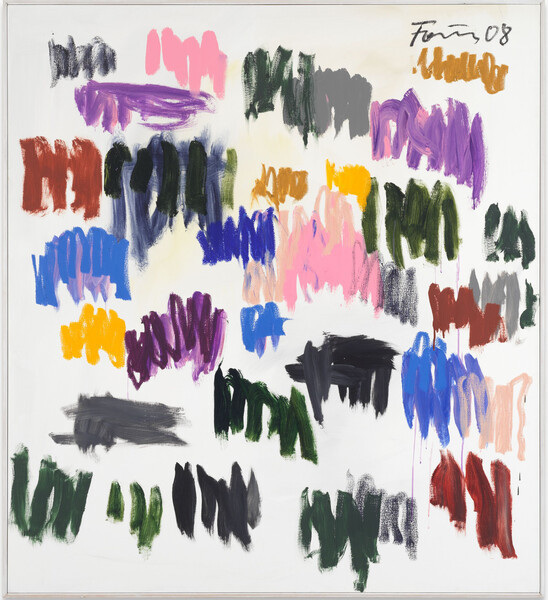Exhibition
in London / United Kingdom
- Günther Förg: Untitled, 2008, acrylic and oil on canvas, 155 x 140 cm, 61 x 55 1/8 in, Photo Serge Hasenböhler, © Estate Günther Förg, Suisse / DACS 2023
Günther Förg was a prolific painter, sculptor, graphic designer and photographer whose daring conceptual works incorporate and critique tropes of the sprawling movement known as modernism. This exhibition, in the North Gallery of the London space, displays Förg’s “Spot Paintings”, the artist’s final series made between 2005 – 2010 before he stopped painting in 2010 after suffering a stroke. Named the “Tupfenbilder” series after the German word for ‘spot paintings,’ this body of work celebrates the act of painting, drawing on Förg’s earlier painterly practice but reimagining his previous explorations in innovative ways. In the artist’s own words, ‘I think painting is a resilient practice; if you look through the history of painting it doesn’t change so much and we always see it in the present. It is still now.’
In these works, the brushstroke itself becomes the main protagonist, representing an ultimate return to expressive painting, indicating a completion of sorts — a full-circle arrival at painting as a synthesis of experimentation, rooted in art history. The “Spot Paintings” were partially influenced by photographs Förg saw of Francis Bacon’s studio, which was covered in colourful blotches of paint created when the artist would wipe his brushes on the walls and door of the studio to remove excess paint. This method was all too familiar to Förg, who would frequently work out the value of a color by dabbing pigment from his brush to a paper or cloth surface. In this way, ‘Untitled’ (2007), as with his other “Spot Paintings”, enacts an irreverent reversal of artistic tradition. In doing so, ‘Günther Förg pushed himself to the brink of discord — but only to preserve art in a precarious state of balance: Balance between the traditions of the past and the needs of the present. Balance between austere rationalism and ardent sensuality. Balance between rigor and wit. Balance between composition and turmoil. Balance between pure artistic means and societal representation. Balance between conceptualism and corporeality,’ as stated by art historian Christian Malycha.
Günther Förg is one of the most significant German artists of the postwar generation. In the breadth of his production, from monochrome painting to colour studies, from photography to wall paintings, from bronze reliefs to sculptures, Förg explored what art critic Kirsty Bell describes as ‘the visual field,’ swiftly moving between mediums and series with an abruptness that so characteristically defined the artist and his work. Like many of his contemporaries, including his friends Martin Kippenberger, Albert Oehlen and Christopher Wool, Förg would devote his practice to wrestling with the feeling of disenchantment with painting and the binding ties to modernism.
The expressive, dynamic brushstrokes and dabs of colour which make up this body of work convey a playful, chromatic harmony. Förg has transformed the previous lattice structures from his renowned series of “Grid Paintings” into rhythmic, gestural marks that appear to float across monumental canvas, doing away with any previous sense of order. Across the variations of “Spot Paintings” on display, contrasting shades of greens, pinks, reds, browns and yellows dominate the bustling composition of intersecting cool and pastel hues, which reflect the conceptual principles that underpinned Förg’s practice: a formal purism, a sense of the artwork as object and an architectural, analytical interest in space. Förg uses off-white background colours and even grey in some instances, bringing a certain solemnity to the paintings in contrast with some of the brighter, energetic colours.
Upon closer inspection, some of the brushstrokes are spontaneous and others are controlled, slow and precise, as the pursuit of pure abstraction required Förg to measure himself, to ensure the brushstrokes remained definitively abstract. The art historian and curator Rudi Fuchs describes this effect: ‘The different movements of brush that make up the painting, are subtly different in manufacture. They have, as it were, different formal temperaments. Decisive, hesitant, fragile, tentative, abrupt, compact. One cannot even begin to appraise the effect of floating, dancing colours.’ The variations in the brushstrokes work to avoid any sense of a recognisable pattern, as Rudi Fuchs continues to say, ‘hanging there, fuzzy as they all are, their precise role is to avoid any recognizable shape and to be utterly and truly abstract.’
Günther Förg was born in 1952 in the region of Allgäu, Germany. His career began in the early 1970s as a student at The Academy of Fine Art Munich. During his studies, Förg developed a practice grounded almost exclusively in grey and black monochrome. These early investigations into gray — also called ‘Gitter’ paintings — demonstrate the beginning of a lifelong commitment to conceptualism. As he stated, ‘Grey is nothing: not white, not black. Something in between. Not concerned with the figure. Something free.’ While the artist later incorporated color into his monochrome series, his use of gray represents a neutral foundation from which he conceived his oeuvre.
Gallery hours Mon-Sat 10 am – 6 pm
Exhibition Duration 01 February – 29 April 2023
Location:
Hauser & Wirth
23 Savile Row
W1S 2ET London
United Kingdom


